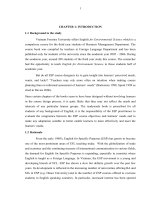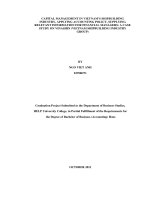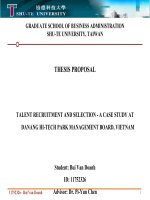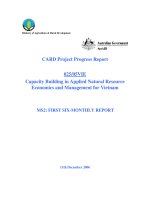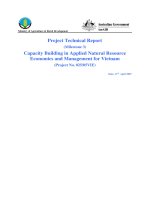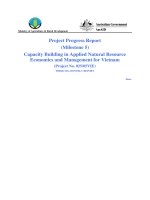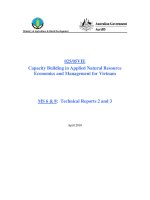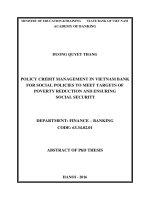TALENT RECRUITMENT AND SELECTION - A CASE STUDY AT DANANG HI-TECH PARK MANAGEMENT BOARD, VIETNAM
Bạn đang xem bản rút gọn của tài liệu. Xem và tải ngay bản đầy đủ của tài liệu tại đây (2.06 MB, 37 trang )
GRADUATE SCHOOL OF BUSINESS ADMINISTRATION
SHU-TE UNIVERSITY, TAIWAN
THESIS PROPOSAL
TALENT RECRUITMENT AND SELECTION - A CASE STUDY AT
DANANG HI-TECH PARK MANAGEMENT BOARD, VIETNAM
Student: Bui Van Doanh
ID: 11752326
Advisor: Dr. Pi-Yun Chen
Co-advisor: Dr. Nguyen Quoc Tuan
August, 2012
1
11752326 - Bui Van Doanh
TALENT RECRUITMENT AND SELECTION - A CASE STUDY
AT DANANG HI-TECH PARK MANAGEMENT BOARD, VIETNAM
2
11752326 - Bui Van Doanh
TALENT RECRUITMENT AND SELECTION - A CASE STUDY
AT DANANG HI-TECH PARK MANAGEMENT BOARD, VIETNAM
TABLE OF CONTENTS:
1. Introduction
2. Literature Reviews
3. Research Methods
4. Concluding Remarks
5. References
3
11752326 - Bui Van Doanh
TALENT RECRUITMENT AND SELECTION - A CASE STUDY
AT DANANG HI-TECH PARK MANAGEMENT BOARD, VIETNAM
Keywords:
1. Technology park
2. Science park
3. Recruitment
4. Selection
5. Employee recruitment
4
11752326 - Bui Van Doanh
1. INTRODUCTION (1/12)
1.1. Research Background:
- There is no uniformly accepted definition of a Hi-tech Park, and there are several
similar terms which are used to describe similar developments, such as “Research
Park”, “Science Park”, “Business Park”, “Innovation Centre”, etc.
- These parks differ from typical hi-technology business districts in that science parks
and the similar ones are more organized, planned, and managed. Their differences go
from has been concerned science centres to will be concerned science and technology.
- Besides building area, these parks offer a number of sharing resources, such as
uninterruptible power supply, telecommunications hubs, receptionist and security,
management offices, restaurants, bank offices, convention center, parking, internal
transportation, entertainment and sports facilities, etc.
5
11752326 - Bui Van Doanh
1. INTRODUCTION (2/12)
- A "research park" implies the following:
• A high quality, low density physical environment in a park-looking setting;
• Interaction between academics, researchers and commercial organizations and entrepreneurs;
• An environment for research and product development, with conventional production and office
activities excluded.
- A "science park" can be defined as a property-based initiative which:
• Has formal operational links with one or more universities, research centers, or other institutions
of higher education;
• Is designed to encourage the formation and growth of knowledge-based industries and other
organizations normally resident on site;
• Has a management function which is actively engaged in the transfer of technology and business
skills to tenant organizations
(Australian Department of Industry, Technology & Commerce, 1989b, p.7).
- A "technology park" can be defined broadly as a collection of high technology industrial
companies concerned with both research and manufacturing, located in attractive, well-landscaped
surroundings, and situated within a reasonable catchment area of a scientific university or a major
research institute
(Australian Department of Industry, Technology & Commerce, 1989b, p.17).
6
11752326 - Bui Van Doanh
1. INTRODUCTION (3/12)
- The world's first science park started in the early 1950's is
Stanford Industrial
Park, in the Silicon Valley of northern California.
- The establishment of science parks in USA drew considerable attention in
Europe and other parts of the world.
- In 1960, there were only 6 science park projects in the world (5 in USA and 1
in the former Soviet Union). During the next decade, both Sweden and the UK
established their first parks. By the 1970s, science parks had been established in
Belgium, Japan, Korea, Taiwan and a number of other countries, amounting to
some 50 projects in 13 countries
- From the 1980s, the whole world witnessed the explosion in the establishment
of science parks. By 1990s, there were over 1000 parks around the world. It was
found that the distribution of science parks among the top ten leading countries
in 1992 was: The USA-393 cases, Germany-106, Japan-104, China-52, the UK-
50, France-35, Australia-33, Canada-31, Sweden-15, and Russia-14.
7
11752326 - Bui Van Doanh
1. INTRODUCTION (4/12)
- In Asia, the first hi-tech park was built in Japan in the 1970s
with the name "Science City" Tsukuba. Other hi-tech parks were
established following Tsukuba, including Hsinchu (Taiwan),
Selangoge and Bangalore (India)…
- To now, there are 300 hi-tech parks in Asia and 800 in the world.
- Each Hi-tech park’s establishment leads to the formation of the
management agencies: the council, the management board or a
company
- These agencies have the main functions: building Hi-tech park
infrastructure, land leasing, construction management, environmental
protection in the Hi-tech park, or issued the preferential and support
investment policies.
8
11752326 - Bui Van Doanh
1. INTRODUCTION (5/12)
Hi-tech park's benefits:
- Technology transfer from the university to the industrial partners.
- Increase of employment opportunities.
- Increase the number of successful companies in technology based
industries especially those supporting the major national industries.
- Development of the high-value-added industries.
- Creation of development funds from the operating surpluses to
provide for the future growth of the Park.
- Help in the establishment of joint research projects between the
members of the park.
- Providing a forum for meetings and contacts between various
researchers, technical specialists, and university professors.
9
11752326 - Bui Van Doanh
1. INTRODUCTION (6/12)
10
11752326 - Bui Van Doanh
Hoalac
Hi-tech park
HHTPMB
Manage
Danang
Hi-tech park
DHTPMB
Manage
Saigon
Hi-tech park
SHTPMB
Manage
(*) HHTPMB: Hoalac hi-tech park Management Board
DHTPMB: Danang hi-tech park Management Board
SHTPMB: Saigon hi-tech park Management Board
Hi-tech parks in Vietnam
DHTP
1. INTRODUCTION (7/12)
Danang hi-tech park
11
11752326 - Bui Van Doanh
1. INTRODUCTION (8/12)
Danang Hi-tech Park Management Board
- Being established according to Decision 1980/QD –TTg dated 28th
October 2010 by Prime Minister
- Function: Government Authority for DHTP
- Mission:
+ Set up orientating plan and development strategy for DHTP;
+ Manage and organize plan implementation;
+ Manage investment, construction and using of the infrastructure in DHTP;
+ Manage land use in DHTP;
+ Manage investment projects, support and promote investment;
+ Manage, protect natural resources and environment; ensure sustainable
development ;
+ Manage labour, residents and security in DHTP;
+ Cooperate with foreign investors;
+ Carry out inspections for businesses in DHTP.
12
11752326 - Bui Van Doanh
DANANG PEOPLE’S COMMITTEE
DHTP
MANAGEMENT BOARD
OFFICE
PLANNING
INVESTMENT
ACCOUNTING
FINANCE
INVESTMENT
PROMOTION AND
SUPPORT
PLANNING, CONS-
TRUCTION AND
ENVIRONMENT
ENTERPRISE
AND LABOUR
MANAGEMENT
TECHNOLOGY
RESEARCH,
APPLICATION AND
DEVELOPMENT
INSPECTION
R&D, APPLICATION
OF TECHNOLOGY
TRAINING CENTER
SERVICES CENTER
HI-TECH BUSINESS
INCUBATION
CENTER
HI-TECH
PARK
CONSTRUC
-TION
INVESTMENT
PROJECT
MANAGE
-MENT
UNIT
DHTP’S
ORGANIZATION CHART
1. INTRODUCTION (9/12)
13
11752326 - Bui Van Doanh
1. INTRODUCTION (10/12)
- The construction and development of Danang Hi-Tech Park is successful
as other Hi-Tech parks in Asia or not require Danang Hi-Tech Park
Management Board to have policies for recruitment and selection the staff
working effectively.
- Danang City government has decreed many policies about humance
resource tranning program and talent attraction. This is a great advantage
for the talent recruitment and selection in Danang Hi-Tech Park
Management Board.
- At present, number of staffs who are employed to work at the Danang Hi-
Tech Park Management Board more than 50 people, not enough to cover
the actual needs. In the future, it is necessary to recruit more than 100
people.
14
11752326 - Bui Van Doanh
1. INTRODUCTION (11/12)
1.2. Research Motive:
- Danang's objectives from 2010-2015 are: develop a high-tech
industry, an information technology industry, and a high-quality
human resource.
- DHTPMB has just been established in 2010, its function is:
government authority for DHTP. It is very nessessary to select
and recruit high-quality staffs to manage DHTP effectively.
- Talent recruitment and selection is a problem of Danang City
government in gerneral and DHTPMB in particular. There is no
solution yet. Therefore, I want to research this topic to find
solutions to DHTPMB at which I am currenly working.
15
11752326 - Bui Van Doanh
1. INTRODUCTION (12/12)
1.3. Research Purpose:
- Through this reaserch, I will be able to assess the advantages
and disadvantages of methods of talent recruitment and
selection at DHTPMB. Also, I can find the weaknesses and
improve them.
- Based on the results of this findings, I will suggest solutions
to improve the talent recruitment and selection for DHTPMB.
16
11752326 - Bui Van Doanh
2. LITERATURE REVIEWS (1/9)
17
11752326 - Bui Van Doanh
2. LITERATURE REVIEWS (2/9)
- The Origins of the concept of HRM was first defined by Bakke (1966) who
wrote that: The general type of activity in any function of management… is to
use resources deffectively for an organizational objective… The function which
is related to the understanding, maintenance, development, effective
employment, and integration of the potential in the resource of ‘people’ .
- The first detailed statements of the HRM concept was made by the
Michigan school (Fombrun et al, 1984). They further explained that there is a
human resource cycle that consists of four generic processes or functions that
are performed in all organizations: selection, appraisal, rewards and
development.
- The other pioneers of HRM in the 1980s were the Harvard school of Beer et
al (1984) who developed what Boxall (1992) called the ‘Harvard framework’.
- Today, many pressures are demanding a broader and more comprehensive and
strategic perspective with regard to the organization’s human resources.
18
11752326 - Bui Van Doanh
2. LITERATURE REVIEWS (3/9)
19
- Recruitment is best described as the way
in which an organisation tries to source
or attract the people from whom it will
ultimately make selections. Recruitment
strategies include efforts to reach better
pools of candidates and to sell the
organisation as an employer of choice.
- Selection is about choosing between job
candidates. It is about how to make a fair
and accurate assessment of the strengths and
weaknesses of applicants and how to identify
the candidate who is most likely to perform
well in the job.
Roberts, G. (1997), Recruitment
and Selection - A Competency Approach, CIPD.
11752326 - Bui Van Doanh
2. LITERATURE REVIEWS (4/9)
o Purpose of Recruitment and Selection:
Attract and hire new employees who have the abilities, skills, and
experiences that will help an organization achieve its goals.
o Recruitment is the process of searching for prospective
employees
and stimulating them to apply for jobs in the organisation.” Edwin
B.Flippo.
o Selection is the process of differentiating between applicants in order
to indentify and hire those with a greater likelihood of success on
the jobs.” Thomas Stone.
20
11752326 - Bui Van Doanh
2. LITERATURE REVIEWS (5/9)
-
Employee Recruitment:
According to Michael, A., Armstrong’s Handbook of Human
Resource Management Practice, Recruitment is the process of
finding and engaging the people the company needs. The
recruitment will run through 4 stages:
- Defining requirements
- Planning recruitment campaigns.
- Attracting candidates
- Selecting candidates
21
11752326 - Bui Van Doanh
2. LITERATURE REVIEWS (6/9)
22
11752326 - Bui Van Doanh
Components
of a Human
Resource
Management
System
2. LITERATURE REVIEWS (7/9)
Linkage of recruitment to human resource acquisition
23
11752326 - Bui Van Doanh
HR Planning
Job analysis
Recruitment
Selection Placement
2. LITERATURE REVIEWS (8/9)
24
11752326 - Bui Van Doanh
2. LITERATURE REVIEWS (9/9)
25
11752326 - Bui Van Doanh
Selection Tools
